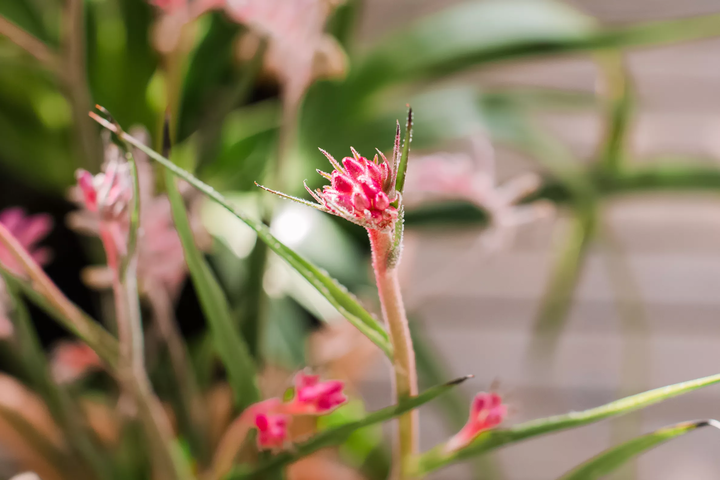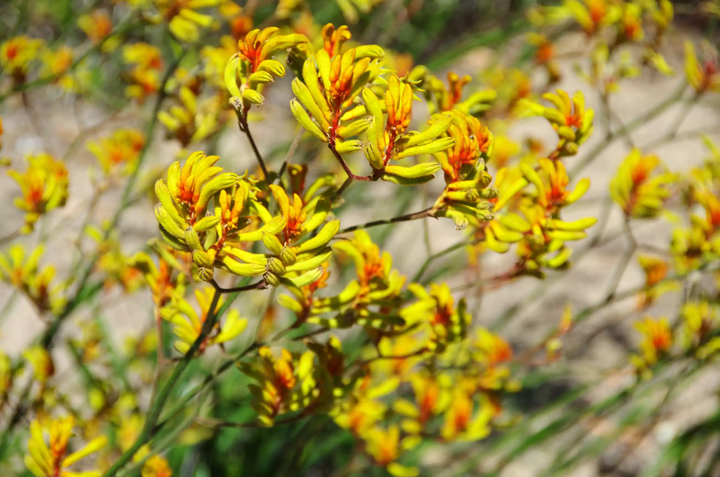Kangaroo paw (Anigozanthos) is a genus of 11 species and multiple subspecies of flowering plants that are native to Australia. These plants have long, slender, arching leaves similar to the foliage of daylilies or amaryllis plants. The unusual tubular flowers grow on stalks in fan-like rows and are covered in velvety fuzz, giving them the appearance of an animal’s paw. The blooms come in an array of shades, including red, orange, yellow, and purple. Kangaroo paw plants grow fairly quickly and don’t require much maintenance. Plant them in the spring after the threat of frost has passed.
Botanical Name:
Anigozanthos
Common Name:
Kangaroo paw, cat's paw
Plant Type:
Herbaceous perennial
Mature Size:
2 to 10 feet tall and 1 to 2 feet wide
Sun Exposure:
Full sun
Soil Type:
Sandy, rich, medium moisture, well-draining
Soil pH:
Slightly acidic
Bloom Time:
Late spring to fall
Flower Color:
Red, orange, yellow, pink, purple, white
Hardiness Zones:
10 to 11
Native Area:
Australia

How to Grow Kangaroo Paw
Kangaroo paw plants are relatively hardy and easy to care for. They can thrive when grown in the ground or in a container. The dwarf varieties are especially ideal for containers. Either way, one of the keys to growing them is fast-draining soil.
If you live in USDA hardiness zones 10 to 11, you can plant kangaroo paw in your garden and expect it to come back year after year as a perennial. However, if you live in a cooler climate you’ll either have to bring your kangaroo paw indoors for the winter or treat your plants as annuals, letting them die at the end of the growing season in the fall and replacing them with new plants the next spring.
Light
These plants prefer to grow in full sun. At least six hours of direct sunlight on most days will enable kangaroo paw plants to produce the best growth and blooms. They can even tolerate intense light from hot afternoon sun. Insufficient light can cause tall plants to flop over and lessen bloom production.
Soil
These plants naturally grow in sandy soil with a slightly acidic soil pH. But they can tolerate a variety of soil types, as long as there is good drainage. For container plants, use an all-purpose potting mix amended with a few handfuls of sand.
Water
Kangaroo paw plants prefer a moderate amount of soil moisture, though they have some drought tolerance. Soggy soil can cause root rot and kill the plants. So wait until the top couple inches of soil are dry to the touch before watering. However, in the spring and summer when most of the blooming occurs, kangaroo paw does appreciate some additional water.
Temperature and Humidity
These plants thrive in the heat, and frost can be fatal to them. They like temperatures between roughly 70 and 80 degrees Fahrenheit. And once the temperature falls below 50 degrees it's time to bring them inside. They also naturally thrive in dry conditions but can tolerate some humidity, too.
Fertilizer
Kangaroo paw plants aren't heavy feeders, so regular fertilizer isn't necessary. In the spring before the flower stalks appear, add a cup or two of compost to the soil to promote healthy growth.
Propagating Kangaroo Paw
If you're patient, you can propagate your kangaroo paw plants from seed planted in the spring. Presoak seeds in hot water for two hours to soften the seed coat and increase the chances of germination. Place them on warm, moist seed-starting soil. Keep the soil moist, and don't give up on germination until at least six weeks have passed. You also can propagate the plants by division, cutting apart mature plants at the roots with a sharp knife and replanting them wherever you desire. Dividing plants every few years also can help to promote healthy growth.
Pruning
Kangaroo paw plants respond well to heavy pruning. Cut back the plants—leaves, flower stalks, and all—to 6 inches above the soil line after the blooms have faded. This will prevent old foliage from becoming diseased and promote denser growth. You also might be rewarded with a second, smaller flush of blooms toward the end of the growing season.
Common Pests and Diseases
Although these plants have no serious problems with pests or diseases, watch your kangaroo paw plant for signs of ink spot disease. The fungus manifests itself as blackening of the leaves and stems. Remove diseased foliage, and aim to prevent the fungus by keeping plants in full sun with good air circulation and well-draining soil.
Varieties of Kangaroo Paw
From the wild species, breeders have worked to create cultivars with increased disease resistance and showier flowers. Some popular kangaroo paw plants include:
Red and green kangaroo paw (Anigozanthos manglesii): The floral emblem of Western Australia, this plant produces green and red flowers and stems.
Tall kangaroo paw (Anigozanthos flavidus): This species features flowers that are usually a yellow-green color and grows to around 6 feet tall.
Little kangaroo paw (Anigozanthos bicolor): This plant remains less than 2 feet tall and produces yellow-green and red flowers.
